Understanding website traffic.
Website traffic data is a goldmine of valuable insights, but unlocking its true potential can be a challenge. Thanks to evolving consumer behaviour and privacy regulations, traditional analytics tools might struggle to provide the granular detail needed to grasp online performance fully. That’s where Google Analytics 4 (GA4) steps in as a powerful solution.
In this guide, we’ll explore GA4’s key functionalities for marketers and how to utilize the platform to uncover hidden traffic patterns, understand attribution channels, and transform data insights into actionable strategies for achieving your organization’s goals.
Why is it important?
Web traffic should be the guiding light of any business with a digital presence. The old adage “if you build it, they will come” simply doesn’t hold water in a competitive online landscape. Websites need to cater to their users, solving problems quickly and efficiently. This requires a deep understanding of user needs and behaviours, which is where website traffic data comes in.
With GA4, marketers can access a wealth of data to provide insights into how users interact with a website. From basic metrics such as page views and session duration to more advanced insights like engagement and path explorations, GA4 provides a myriad of tools for data detectives to uncover clues about their audience.
Eliminating blind spots with unified tracking.
One of GA4’s key advantages (and a major difference from its predecessor, Universal Analytics) is its ability to track user behaviour across multiple platforms and devices. This provides a unified view of user interactions, eliminating blind spots and black holes in your data.
By bringing iOS, Android, and website data streams together into a single property, GA4 offers a holistic view of the audience’s journey. It allows marketers to see how users interact with their business across different digital touchpoints, providing valuable insights that can be used to identify opportunities for optimization and improvement.
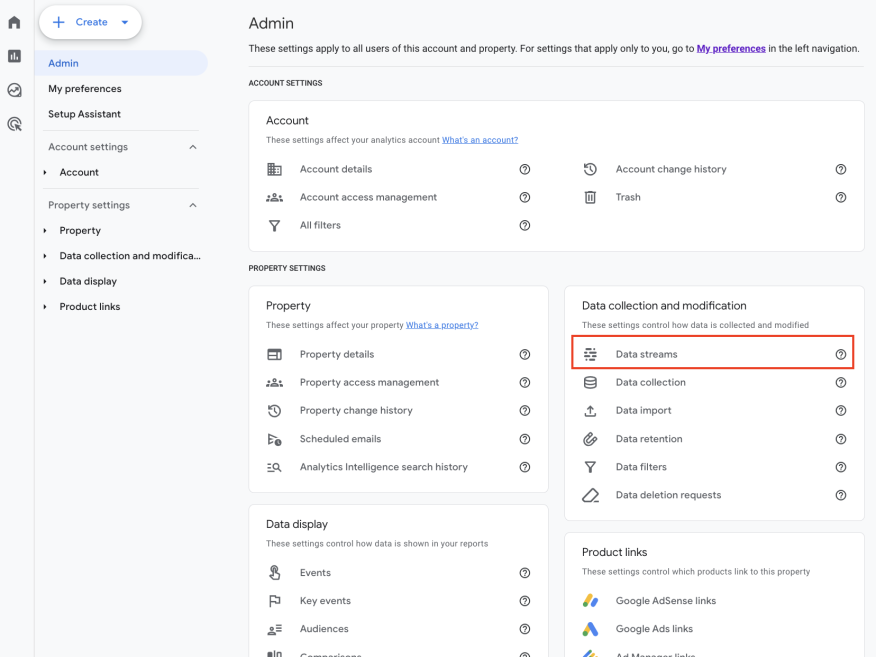

From FOMO to focus.
It’s common for organizations to fall prey to the “track everything” mentality, hoarding data for a mythical “one day” when it might be helpful. We encourage our clients to take a leaner approach, be selective in what they track, and give their data purpose and direction. Let that data spark joy, as Marie Kondo might say!
Here’s why a focused approach is key:
- Avoid bogging down your website: Tracking too many metrics can lead to website bloat, slow page load times, and frustrated users. By focusing on essential metrics, you can keep your website running smoothly and ensure a positive user experience.
- Ditch data paralysis: Managing a mountain of data can be overwhelming and time-consuming. When data collection becomes a burden, valuable insights can get lost, and inaccuracies might creep in. Streamlining your tracking efforts allows you to maintain cleaner, more accurate data that’s easier to analyze and act on.
- Identify what truly matters: Vanity metrics like page views or social media likes might make you feel good, but they offer little actionable insight. Focus on metrics that align with your business goals, like conversion rates or time spent on key pages. By eliminating the noise of irrelevant data, you can better identify trends, patterns, and opportunities for optimization.
- Find clarity & focus: Tracking the most relevant metrics gives you a clear picture of what truly matters to your organization’s success. This clarity empowers you to prioritize resources, set achievable goals, and measure progress effectively. Instead of drowning in a sea of data, you can focus on the metrics that directly impact your bottom line and drive meaningful change.
Rather than striving to track everything, focus on the metrics that matter most to your business objectives and KPIs. Use these insights to inform strategic decision-making and propel your website towards continuous improvement.
How to track meaningful metrics.
Events
Generic event tracking is included in the default GA4 setup, but this doesn’t include actions unique to your business. Custom events must be set up manually through Google Tag Manager and can include button and link clicks, page loads, newsletter subscriptions, form submissions, file downloads, and video views, just to name a few.
Key Events
Once your events are set up, you can mark the most valuable actions as “key events”. These are typically the metrics of greatest interest to marketing teams and boards, such as purchases, sign-ups, registrations or lead submissions.
Note: Key events were formerly called “conversions” and have been renamed to differentiate them from conversions in Google Ads; at the time of writing this article, the update is in a gradual feature rollout, so you may still see these terms used interchangeably.
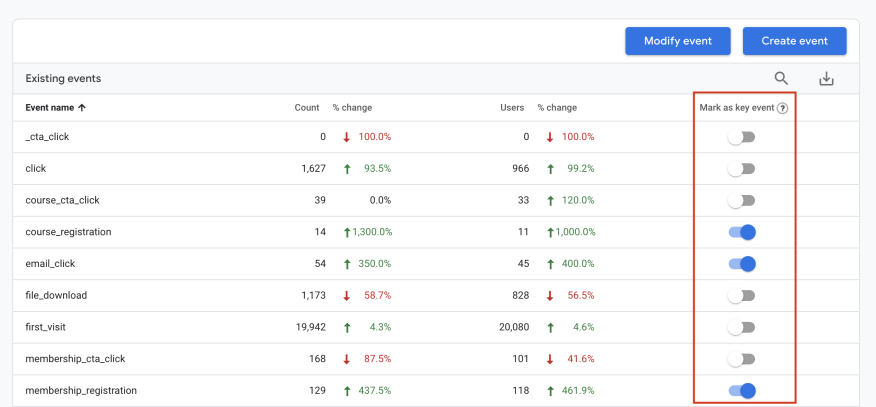
By setting up events in GA4, you can gain valuable insights into how users engage with your website or app, identify areas for improvement, and measure the effectiveness of your marketing efforts. Additionally, events serve as valuable data points for building audience segments, creating custom reports, and optimizing your digital marketing strategies.
External impacts on website traffic.
When analyzing data, it’s essential to consider the time frames being compared and any external factors influencing results. Understanding these influences can provide valuable context for interpreting patterns and fluctuations.
Seasonal variability.
For businesses with seasonality, comparing peak and low seasons likely won’t provide meaningful insights. Take the Peloton app as an example. Their customers might be rockstars in January, but by July, poolside cocktails will replace those beach-bod goals. Similarly, website traffic for ski resorts probably won’t peak in June.
One of our favourite ways to help investigate these anomalies is using Google Trends, which allows you to view search volumes for specific terms over time. For example, let’s say you’re a clothing retailer. You might view search interest for “summer dresses” and see a surge in spring, followed by a decline in fall. This predictable pattern helps you understand seasonal trends in your industry, allowing you to plan marketing campaigns accordingly.
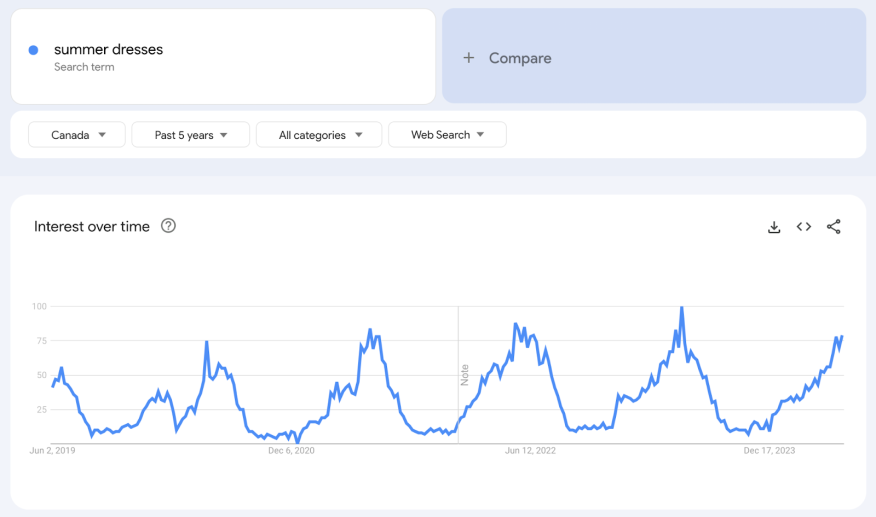
Understanding seasonal trends helps us to interpret data and avoid misinterpretations. As an agency, we often report on year-over-year comparisons, as this offers a clearer picture of marketing effectiveness independent of seasonal ebbs and flows.
Market changes.
Remember the fidget spinner craze of 2017? Search interest went from supersonic to slower than a sloth on a Sunday. It’s a perfect example of how external factors can dramatically impact website traffic data.
Before you hit the panic button and blame your marketing efforts, take a step back and consider the bigger picture. Remember, marketing doesn’t happen in a vacuum. External factors can significantly influence your data, so it’s crucial to consider the broader context before making decisions about your strategy.
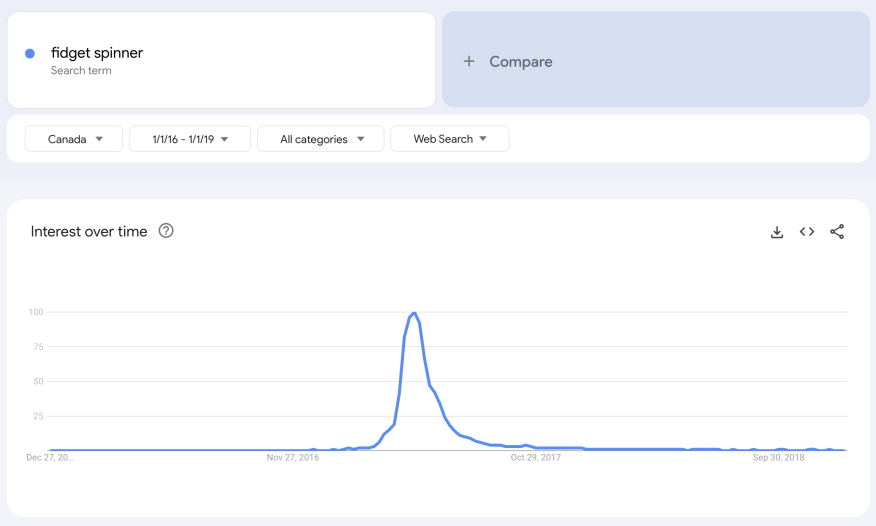
The rise and fall of fidget spinners are a great example of market change driven by consumer trends. However, the economy, inflation, global conflicts, and unforeseen events can also cause unexpected shifts in traffic. For instance, an airline company tracking ‘flights to New York’ over five years would see a significant drop in March 2020 due to pandemic lockdowns. Even the most significant marketing strategy can’t withstand a mandated shutdown.
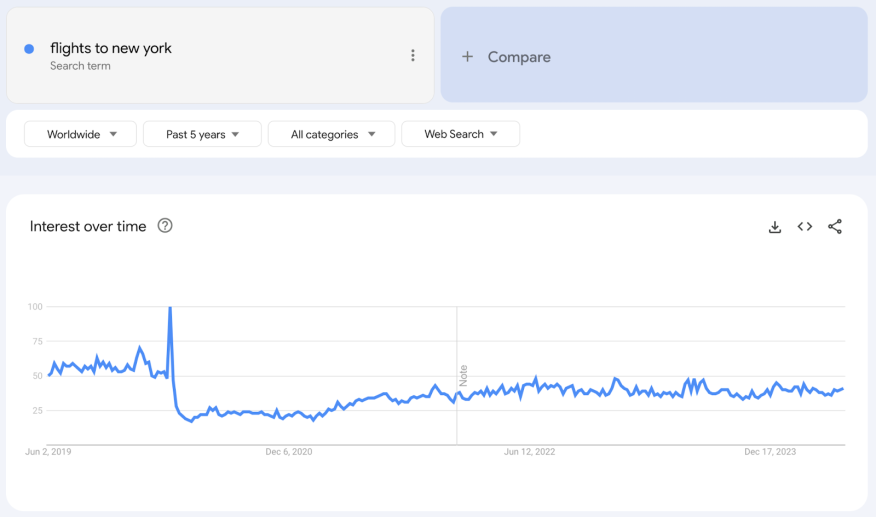
While we can’t predict the future, tools like Google Trends act as valuable historical data sources, allowing us to uncover patterns that influence the present. Understanding these external forces enables you to make informed decisions about your marketing strategies.
User privacy limitations.
The evolving landscape of user privacy, with more people opting for privacy-focused browsing and limited tracking, presents challenges for data collection. Each new iOS version introduces enhanced privacy features, further complicating matters for marketers tracking user journeys.
GA4 addresses these privacy concerns by prioritizing transparent data collection practices, emphasizing consent and compliance with regulations like GDPR. With advanced data retention and sharing settings, GA4 enables businesses to respect user privacy while still deriving valuable insights for decision-making.
Decoding what shapes your data.
Understanding seasonal changes, market shifts, and tracking limitations is crucial for interpreting data effectively. While these factors can impact outcomes, knowing them helps make sense of the data and guides informed decision-making. By staying proactive and embracing a holistic view, businesses can leverage knowledge to drive meaningful strategies.
Cracking the code of attribution.
Ever wonder what makes a visitor convert to your website? Was it that information-packed, 3000-word (aka. your blood, sweat, and tears) blog post or the targeted search ad that caught their eye? Understanding which marketing channels deserve the credit can feel like piecing together a puzzle. Attribution in GA4 is your missing piece, helping you see the complete picture.
In the past, attribution modeling was often complex and challenging. However, GA4 simplifies this process with its enhanced attribution capabilities.
Exploring attribution models.
GA4 offers several attribution models, each with its strengths. Think of them like different tools in your marketing toolbox. You’ll choose the one that best tackles your specific marketing goals. By understanding these models, you can better understand your data and make smarter decisions.
Farewell to the old guard.
As of last year, some attribution models (first click, linear, etc.) were shuffled off to the data graveyard. These models couldn’t keep up with the ever-evolving customer journey. As it currently stands, marketers can still select data-driven attribution, last click, and external attribution, though data-driven attribution is the recommended approach.
Why data-driven?
Imagine a visitor reading your blog post (touchpoint 1), clicking on a social media ad (touchpoint 2), and finally converting (marketing team fist pump!). Data-driven attribution, powered by Google AI, credits all these touchpoints, not just the last click. This is crucial for understanding what influences conversions and allows you to allocate your marketing budget wisely.
Understanding attribution and utilizing GA4’s powerful features can transform your marketing efforts from guessing games to data-driven strategies.
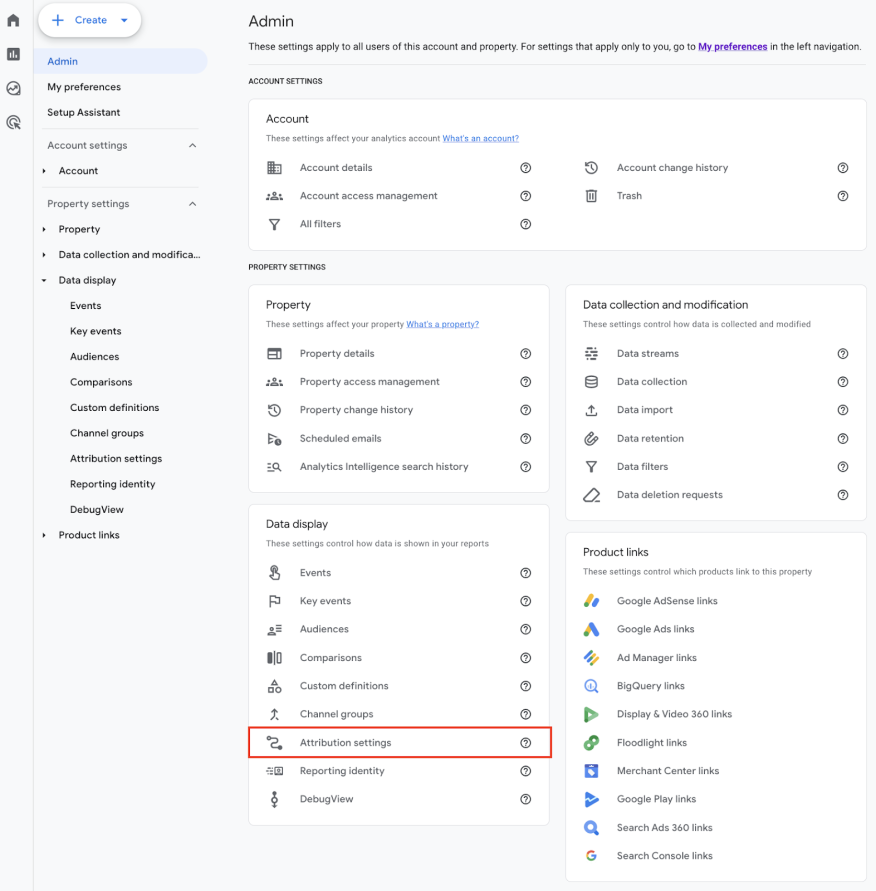
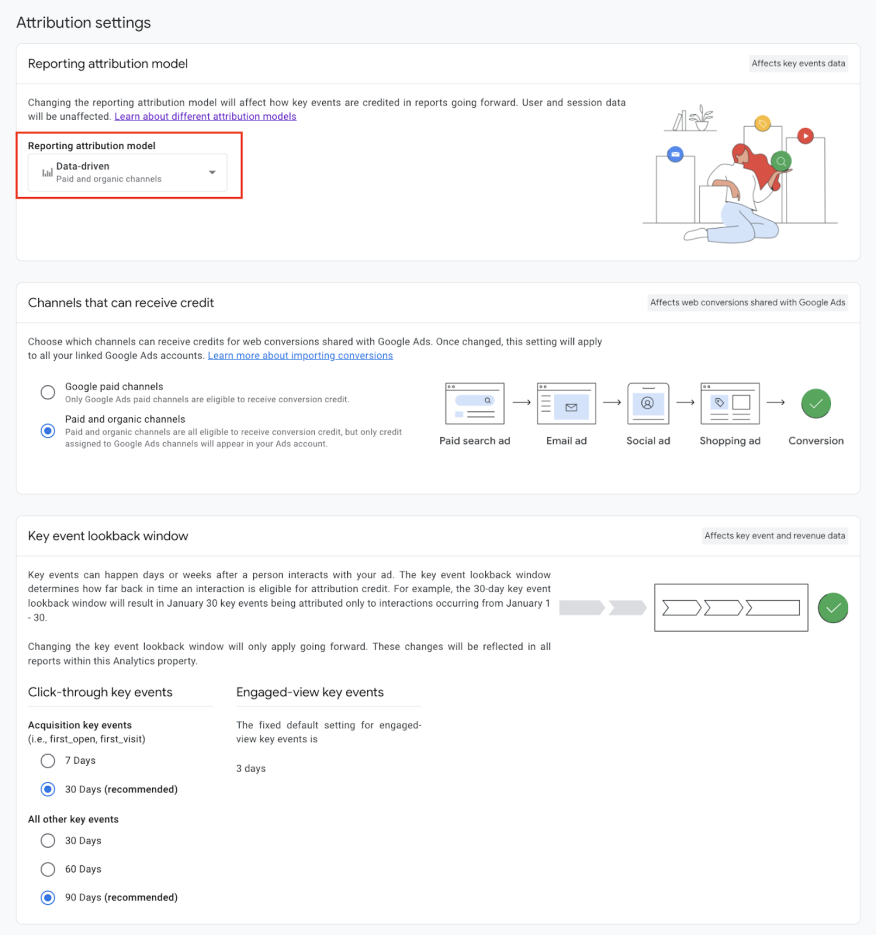
GA4 best practices and tips for marketers.
Getting reliable and impactful data from GA4 requires careful planning and execution. Here are some best practices and tips for analysts looking to get the most out of the platform:
- Devote the necessary time to properly configure GA4 and verify that tracking is set up accurately; this is one of the first things we check when onboarding new clients. We regularly come across websites where multiple plugins insert the analytics tag, resulting in duplicate tracking and data inaccuracies. For example, if you’re looking at your metrics and notice a bounce rate below 25%, a surge in page views and a suspiciously low session duration, there’s a good chance that double-tracking might be at play.
- Familiarize yourself with GA4’s interface and features, and take advantage of online resources and documentation; the Google Analytics help center is a great resource for unsure processes or metrics.
- Review and analyze your GA4 data regularly to identify trends, patterns, and opportunities for optimization. Establishing a strong baseline provides invaluable insights for comparison and strategic decision-making.
- Beware of bot traffic; if you’re a purely Canadian-based organization, you may find it helpful to filter your traffic to Canadian audiences only. This can help ensure that the data you’re analyzing accurately reflects the behaviour of your target audience and eliminates the noise from irrelevant or non-human traffic (often seen coming from data centers like Ashburn in the U.S.).
- Stay up to date with GA4’s latest developments and updates to ensure that you’re taking full advantage of its capabilities; it’s a relatively new, constantly evolving platform.
Taking action on insights.
GA4 doesn’t just give us data – it equips marketers with the tools to make it actionable. You can:
- Identify your marketing rockstars: Pinpoint the channels that drive conversions and optimize your budget accordingly.
- Know your audience like never before: Segment your visitors based on behaviour to personalize experiences and deliver targeted messaging that resonates.
- Measure campaign effectiveness with laser focus. This will allow you to Uncover what’s working and what’s not, refine your strategies, and maximize your return on investment (ROI).
By leveraging GA4’s data-driven insights, you can transform your marketing efforts from a guessing game into a strategic force, propelling your organization towards continued growth and success.
